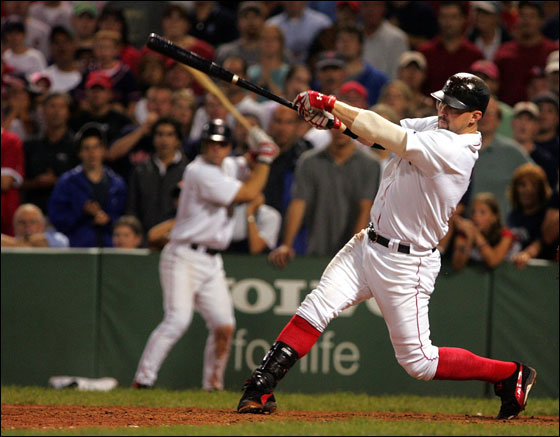100 Greatest Red Sox >> #32 Dick Radatz
Dick Radatz, RP/CL, #17 (1962-1966)
W-L 49-34, 288 G, 104 SV, 557 IP, 627 K, 2.65 ERA Imagine a 6'6" tall wide-body throwing a 95-mph fastball at you from a low-sidearm delivery, and you have an idea of why Dick Radatz terrorized American League batters for several years in the 1960s. -Gabriel Schechter
Imagine a 6'6" tall wide-body throwing a 95-mph fastball at you from a low-sidearm delivery, and you have an idea of why Dick Radatz terrorized American League batters for several years in the 1960s. -Gabriel Schechter
Schechter wrote this in a piece for the Baseball Hall of Fame to honor the passing of Dick "The Monster" Radatz. He was truly an imposing figure on the mound, due both to excellent "stuff" and his physical presence. Radatz was such a bright star in the early 60s for the Red Sox that it seems only fitting that he owes the bookends of his career to two Red Sox legends.
Radatz was born in Detroit, MI, in 1937. He attended Michigan State University, and would begin his track towards Boston as an amateur free agent after graduation. After two seasons as a starting pitcher in the minors, Radatz would be shifted to the bullpen by his manager, Johnny Pesky, in Seattle of the Pacific Coast League. Pesky thought he could be more helpful to the big league club by pitching multiple days, rather than on a set rotation. It didn't hurt that Boston's current "closer", Mike Fornieles, "put up a Pineiro" in 1961 (15 SV, 4.68 ERA). Radatz would become a relief ace for the Red Sox in every sense of the word.
His rookie year, 1962, was by any measure a success. He saved 24 games, with an ERA+ of 184. He also averaged 2 IP per appearance, providing a high number of quality innings. Unfortunately, Radatz would finish in a three-way tie for the RoY (translation: dead last). This didn't stop him from putting together an even better season in 1963. He certainly got plenty of attention. His 1963 line: 191 ERA+, 15-6, 25 SV, 66 G, 132 IP and 162 K. He made such an impact on the upstart and highly-competitive seventh-place Red Sox that he was 5th in MVP balloting that season. Just let that sink in for a minute. An example from today's game would be if Octavio Dotel of the 2007 AL Central 5th place Royals managed to garner enough MVP support to finish 5th. The win total might've had something to do with it, and we certainly know more now about the possibility of RPs "vulturing" wins. Later on I'll discuss why this isn't neccessarily the case with Radatz. Schechter:In 1963, his best season, he embarrassed the whole league, leading Yankees manager Ralph Houk to declare that "for two seasons, I've never seen a better pitcher."
Houk should've waited to make this declaration, as 1964 was simply another of the greatest seasons ever by a RP (Boston or elsewhere). He set the record for Ks as a RP with 181. If a team wanted to manipulate their pitching staff enough, this could be matched, but I think Radatz's record is safe. He managed this in 157 IP (all in relief, of course). He also made his second All-Star team (1963 as well).
1965 was a let-down for Radatz and Red Sox fans. The team finished 9th, lost 100 games, and Radatz came back to Earth. Some of this could be attributed to Ted Williams. In Spring Training before that season, Ted suggested to Radatz that he develop a sinker in order to better attack LHH. What is one to do when Ted Williams gives you advice? Take it and apply it. Radatz did, and while he felt he developed a pretty good sinker, he never regained his fastball. He had changed his mechanics too much to accomodate the sinker. Without his fastball, Radatz lost the extra in extraordinary. His K/9 dropped below 10 for the first time in his career, and his ability to strikeout hitters would never return to the levels he enjoyed at his peak. His Red Sox career ended when he was traded to the Indians in 1966 for a stamp collection.
While relatively long-lasting compared to others of this phenomenon, Radatz's career could still be described as flash-in-the-pan. He experienced 3 years of greatness, though the teams he toiled for left something to be desired. He was a strong reliever with the ability to throw a lot of innings. Over his 288 G in a Red Sox uniform: 53 G with 3+ IP, and 8 G with 6+ IP. With such lofty innings totals per game, it seems likely that Radatz earned rather than vultured all those relief wins.
"The Monster" would pitch for Cleveland, Chicago (N), his hometown Detroit, and Montreal before his career was finished.Dick Radatz brings one weapon - a fastball. It's like saying all a country brings to a war is an atom bomb. -Jim Murray
There were many ways to describe the way Radatz simply demolished AL hitting from 1962-1964, and I think Murray captures it best.
Radatz died due to a head injury in a home accident on March 16, 2005.
Allen is a constant source of unoriginal content and excruciatingly lame puns. You can find him at Over The Monster.



















